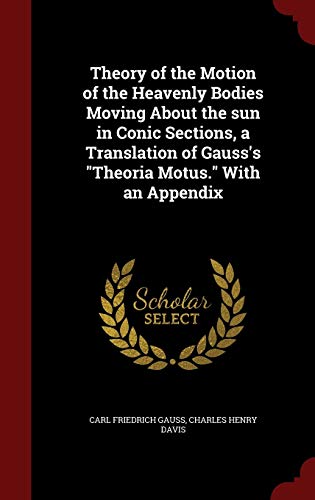معلومات عنا
دعم العملاء
احصل على التطبيق

قم بتوجيه الكاميرا لتنزيل التطبيق
حقوق الطبع والنشر © 2024 Desertcart Holdings Limited



Full description not available
V**O
Important work
This very technical and archaic book is a rather strange book to keep in print. Its entire purpose is the determination of the orbits of heavenly bodies on the basis of limited observations. This was prompted by the discovery of Ceres, which was sighted briefly in 1801 and then lost. For the regular planets one of course has enormous amounts of observational data for determining the orbit, but we are now facing a new problem: to determine the orbit from only a few observations. By Kepler's laws we know that the orbit will be an ellipse and once we know the ellipse we know its orbital period (by the harmonic law, R^2 proportional to period^3). Therefore, to know the position of Ceres at all future times we need to determine the ellipse and the position of Ceres at one given time. A conic has five degrees of freedom (Ax^2+Bxy+Cy^2+Dx+Ey+1=0) and the position at a given time gives one additional degree of freedom, so we should need 6 pieces of data to determine the future positions of Ceres. Each observation gives 2 data (coordinates on celestial sphere), so three observations should be enough to solve the problem and indeed Gauss provides such a solution. To get the most out of the data, Gauss uses the method of least squares and makes careful error estimates and so on. Towards the end of the book Gauss addresses the issue of perturbations. Gauss's prediction of the position of Ceres was a stunning success, but his method does not work as well for Pallas, discovered in 1802, since its orbit cannot be taken to be a perfect ellipse because it is too heavily perturbed by Jupiter and other planets.
J**R
Yes! It's back in print!
The lovely Lady is missing! She's been spotted three times. And the hero, the best and brightest of young Men, goes looking for Her! There is no time to lose. Will she be found by New Year's Day? What an adventure story!Well, actually, this is a book about mathematics and celestial mechanics. And it isn't exactly new: it was written in 1809.But this isn't just a history book. Nor is it nearly impossible to read, like Newton's Principia. This is the exciting tale, in great mathematical detail, of the techniques that enabled Gauss to find Ceres. And how the same methods can be used to find Juno and Pallas given three observations of them, or Vesta given two complete and two incomplete observations.For those who don't know this, Ceres was discovered by Giuseppe Piazzi, a 40-year old mathematics professor, on January 1, 1801. Piazzi observed Ceres twenty more times, the final time on February 11. After that, Ceres was lost. In the September, 1801 issue of the Monatliche Correspondenz, Piazzi published his entire set of observations of Ceres. Karl Gauss, then 24 years old, took only a few weeks to predict the path of Ceres, in surprisingly good agreement with modern values. He sent his results to Franz von Zach, the editor of the Monatliche Correspondenz. On December 31, 1801, von Zach unambiguously confirmed the recovery of Ceres.This book has not aged well, of course. Gauss, one of the greatest mathematicians ever, was forced to do his calculations without the aid of modern computers. And so we see plenty of mathematical tricks that we can all appreciate, but for the most part are unnecessary today (and we can be glad that we rarely need to employ them ourselves).Still, if you want to understand orbital mechanics, this is a remarkably good book to read. It is surprisingly easy to follow all the math, and once you've read it, you'll be able to solve plenty of orbital mechanics problems.And if you ever want to solve some really tough problems in orbital mechanics, Gauss is a great teacher. You'll gain valuable insight about what approximations are available and when to make them.
P**S
Timeless thinking from a genius mathematician.
Incredibly innovative thinking. Superb!!
ترست بايلوت
منذ شهر
منذ أسبوع